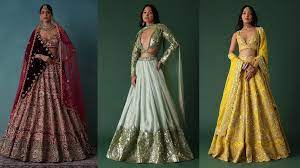
Lehengas, an integral part of traditional Indian attire, have undergone a fascinating evolution over the years. Among the key components of this ensemble, the choli holds a distinct significance. The choli, or blouse, not only complements the lehenga but also serves as a canvas for intricate design elements that convey cultural stories, regional aesthetics, and individual style. In this exploration, we delve into the language of lehengas, decoding the design elements of cholis and unraveling the rich tapestry of history, culture, and artistry.
Historical Roots:
To understand the language of lehengas, it’s crucial to trace the historical roots of this traditional attire. The origins of lehengas can be found in ancient India, where women adorned elaborate garments characterized by vibrant colors and exquisite embellishments. Over time, different regions contributed to the evolution of lehenga-choli ensembles, each leaving a unique imprint on the overall design.
Regional Influences:
The diversity of India is mirrored in the myriad styles of lehenga-choli combinations. The North Indian lehengas, with their voluminous skirts and short cholis, exude a regal charm, often adorned with intricate zari and gota work. On the other hand, South Indian lehengas boast a more modest silhouette, featuring rich silk fabrics and detailed temple-inspired motifs.
East Indian lehengas showcase a fusion of traditional and contemporary elements, with delicate hand embroidery and vibrant color palettes. In the West, the influence of Bollywood has led to a blend of modern and traditional designs, incorporating sequins, mirrors, and unconventional fabrics.
Embroidery and Embellishments:
Embroidery plays a pivotal role in communicating the cultural and artistic heritage of a region. Zardozi, a form of metallic embroidery, is a prominent feature in many North Indian cholis. This intricate art involves sewing gold or silver threads onto the fabric, creating elaborate patterns that exude opulence.
In contrast, Kantha embroidery from East India involves simple running stitches that form beautiful motifs, reflecting the region’s emphasis on handcrafted elegance. The use of mirror work in Gujarat and Rajasthan cholis adds a vibrant, reflective element, capturing the essence of these culturally rich states.
Color Palette:
The color palette of a lehenga-choli ensemble is a language in itself, conveying emotions, traditions, and even social status. Red, symbolizing auspiciousness and bridal attire, remains a timeless favorite. However, the contemporary fashion landscape has seen a surge in experimentation with unconventional colors, with brides opting for pastels, jewel tones, and even monochromatic ensembles.
The choice of color also holds cultural significance. For instance, the use of yellow and green in Rajasthanilehengas reflects the arid landscape and agricultural roots of the region. Similarly, the vibrant hues of Bengali lehengas mirror the festivities and energy of traditional celebrations.
Silhouettes and Cuts:
The silhouette of a choli is another element that contributes to the language of lehengas. The length of the choli, the neckline, and the sleeve style all play a role in defining the overall look. Traditional cholis often feature a tight, fitted bodice with intricate tie-up details at the back, while modern interpretations may embrace off-shoulder, crop-top styles, or even experiment with asymmetrical cuts.
The versatility of choli designs allows for personal expression, and designers continually reinterpret traditional silhouettes to cater to contemporary tastes. The balance between preserving cultural authenticity and embracing modern trends is evident in the evolving landscape of lehenga-choli fashion.
Influence of Bollywood:
Bollywood, as a cultural force, has significantly influenced the language of lehengas. Iconic film moments featuring actresses donning breathtakinglehengas have contributed to changing fashion trends and shaping consumer preferences. Designers often draw inspiration from Bollywood, creating replicas of popular looks or infusing cinematic glamour into their designs.
Celebrities also play a pivotal role in setting trends, with their red carpet appearances and wedding attires becoming fashion benchmarks. The fusion of traditional craftsmanship with contemporary styles, as seen in Bollywood-inspired lehengas, exemplifies the dynamic nature of Indian fashion.
Sustainability and Ethical Fashion:
In recent years, there has been a growing emphasis on sustainable and ethical fashion in the Indian couture landscape. Designers are incorporating eco-friendly fabrics, promoting fair trade practices, and reviving traditional handloom techniques. This shift towards conscious fashion is reshaping the language of lehengas, emphasizing quality over quantity and celebrating the craftsmanship behind each piece.
Conclusion:
The language of lehengas, especially the intricate design elements of cholis, is a captivating narrative that weaves together history, culture, and personal expression. From the rich embroidery of North Indian cholis to the simplicity of East Indian motifs, each design element communicates a story that resonates with the wearer and reflects the cultural tapestry of India.
As the fashion landscape continues to evolve, the language of lehengas will undoubtedly undergo further transformations. However, the essence of this traditional attire lies in its ability to transcend time, embodying the spirit of celebration, cultural diversity, and the timeless elegance of Indian heritage.
Embark on a style odyssey at Harshil Design Studio, located in the heart of Vadodara. Elevate your fashion journey with our exquisite creations, where tradition meets modernity, especially in our stunning lehengacholi ensembles.
Top of Form







